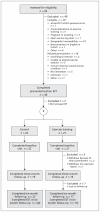Six-month exercise training program to treat post-thrombotic syndrome: a randomized controlled two-centre trial
- PMID: 21098066
- PMCID: PMC3017252
- DOI: 10.1503/cmaj.100248
Six-month exercise training program to treat post-thrombotic syndrome: a randomized controlled two-centre trial
Abstract
Background: Exercise training may have the potential to improve post-thrombotic syndrome, a frequent, chronic complication of deep venous thrombosis. We conducted a randomized controlled two-centre pilot trial to assess the feasibility of a multicentre-based evaluation of a six-month exercise training program to treat post-thrombotic syndrome and to obtain preliminary data on the effectiveness of such a program.
Methods: Patients were randomized to receive exercise training (a six-month trainer-supervised program) or control treatment (an education session with monthly phone follow-ups). Levels of eligibility, consent, adherence and retention were used as indicators of study feasibility. Primary outcomes were change from baseline to six months in venous disease-specific quality of life (as measured using the Venous Insufficiency Epidemiological and Economic Study Quality of Life [VEINES-QOL] questionnaire) and severity of post-thrombotic syndrome (as measured by scores on the Villalta scale) in the exercise training group versus the control group, assessed by t tests. Secondary outcomes were change in generic quality of life (as measured using the Short-Form Health Survey-36 [SF-36] questionnaire), category of severity of post-thrombotic syndrome, leg strength, leg flexibility and time on treadmill.
Results: Of 95 patients with post-thrombotic syndrome, 69 were eligible, 43 consented and were randomized, and 39 completed the study. Exercise training was associated with improvement in VEINES-QOL scores (exercise training mean change 6.0, standard deviation [SD] 5.1 v. control mean change 1.4, SD 7.2; difference 4.6, 95% CI 0.54 to 8.7; p = 0.027) and improvement in scores on the Villalta scale (exercise training mean change -3.6, SD 3.7 v. control mean change -1.6, SD 4.3; difference -2.0, 95% CI -4.6 to 0.6; p = 0.14). Most secondary outcomes also showed greater improvement in the exercise training group.
Interpretation: Exercise training may improve post-thrombotic syndrome. It would be feasible to definitively evaluate exercise training as a treatment for post-thrombotic syndrome in a large multicentre trial.
Figures
References
-
- Kahn SR, Ginsberg JS. Relationship between deep venous thrombosis and the postthrombotic syndrome. Arch Intern Med 2004;164:17–26 - PubMed
-
- Kahn SR, Hirsch A, Shrier I. Effect of post-thrombotic syndrome on health-related quality of life after deep venous thrombosis. Arch Intern Med 2002;162:1144–8 - PubMed
-
- Kahn SR, Ducruet T, Lamping DL, et al. Prospective evaluation of health-related quality of life in patients with deep venous thrombosis. Arch Intern Med 2005;165:1173–8 - PubMed
-
- Kahn SR. How I treat postthrombotic syndrome. Blood 2009;114:4624–31 - PubMed
-
- Gardner AW, Poehlman ET. Exercise rehabilitation programs for the treatment of claudication pain. A meta-analysis. JAMA 1995;274:975–80 - PubMed

